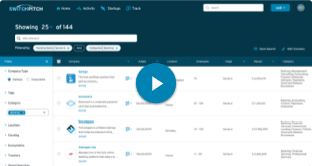
As we move deeper into 2025, the pharmaceutical and life sciences sectors continue to revolutionize healthcare, offering profound insights that innovation teams across all industries can apply. These advances show how embracing technology and collaboration can drive solutions to complex challenges. So, we asked: What can other sectors learn from life sciences innovation?
To explore this, we turned to what we know best—data-driven insights. Using SwitchPitch’s proprietary database of over 500,000 startups, we analyzed how groundbreaking trends in life sciences can inspire innovation everywhere.
Q: How is precision medicine reshaping innovation approaches?
Precision medicine tailors treatments to individual patients by leveraging data like genetics and environment. This shift from one-size-fits-all solutions is reshaping healthcare—and the lesson for other sectors is clear: hyper-personalization can lead to better outcomes.
Startups like Tempus, which uses AI to analyze clinical and molecular data, and Foundation Medicine, which provides genomic profiling to guide treatment decisions, are paving the way for personalized care.
Takeaway: Industries like retail, finance, and manufacturing can adopt hyper-personalized strategies by integrating customer-specific data and tailoring solutions to individual needs.
Q: How is AI accelerating transformation in life sciences?
Artificial intelligence is revolutionizing drug discovery by reducing time and cost. Companies like Insilico Medicine identify promising drug candidates using AI, while Recursion Pharmaceuticals applies machine learning to uncover new uses for existing drugs.
Takeaway: Innovation teams in any sector can use AI to analyze large datasets, uncover actionable insights, and automate processes, driving efficiency and innovation at scale.
Q: What can industries learn from mRNA technology’s rapid success?
The development of mRNA vaccines demonstrated the power of scalability, flexibility, and collaboration under pressure. Startups like CureVac showcased how adaptable technology platforms can rapidly address emerging challenges.
Takeaway: Organizations should invest in flexible infrastructure and forge strong partnerships to enable rapid innovation when new opportunities or crises arise.
Q: How are CRISPR and gene editing transforming problem-solving?
CRISPR technology has revolutionized medicine by enabling precise gene editing to treat genetic disorders. Startups like Editas Medicine and Intellia Therapeutics are leading the way, focusing on correcting genetic mutations to address diseases at their root.
Takeaway: Industries can adopt similar approaches by focusing on core inefficiencies and tackling foundational challenges directly, rather than opting for short-term fixes.
Q: How does collaboration drive life sciences innovation?
From partnerships between startups and established pharmaceutical companies to global efforts during the pandemic, collaboration has proven essential in overcoming barriers. Startups like EQRx, which partners with payers and health systems to lower drug prices, and Owkin, which collaborates with research institutions to advance AI-driven biomedical insights, exemplify the power of collective action.
Takeaway: Breaking down silos and leveraging external expertise can accelerate innovation and enable organizations to achieve larger-scale impact.
Q: What’s next for pharmaceuticals and life sciences?
The life sciences sector is embracing new frontiers, including wearable health tech, regenerative medicine, and AI-driven diagnostics. Startups like AliveCor, which develops AI-powered ECG devices, and BlueRock Therapeutics, focused on stem cell therapy, highlight the sector’s focus on long-term innovation and adaptability.
Takeaway: These advancements emphasize the importance of staying adaptable, forward-thinking, and data-driven, which are critical lessons for organizations across industries.
How can businesses leverage these insights?
“The pharmaceutical industry’s success lies in its ability to align innovation with real-world needs, leveraging data and partnerships to drive measurable impact,” says Michael Goldstein, CEO of SwitchPitch. “Other industries can replicate this by connecting with startups that provide tailored solutions, streamlining processes, and driving better results.”
For example, a global life sciences firm recently used SwitchPitch to identify over 200 potential startup collaborators, accelerating their innovation cycle by 30%. Whether you’re addressing sustainability, improving customer experiences, or solving technical challenges, the key is identifying innovators who align with your goals.
What’s next for your industry?
To stay competitive, organizations must combine data-driven decision-making with scalable innovation strategies. Whether you’re in tech, retail, energy, or beyond, the lessons from pharmaceuticals and life sciences—personalization, AI integration, and collaboration—offer a roadmap for success.
SwitchPitch connects enterprises with over 500,000 startups, using proprietary AI to align innovation needs with cutting-edge solutions. Streamline your innovation process and discover transformative possibilities—start now at SwitchPitch.


